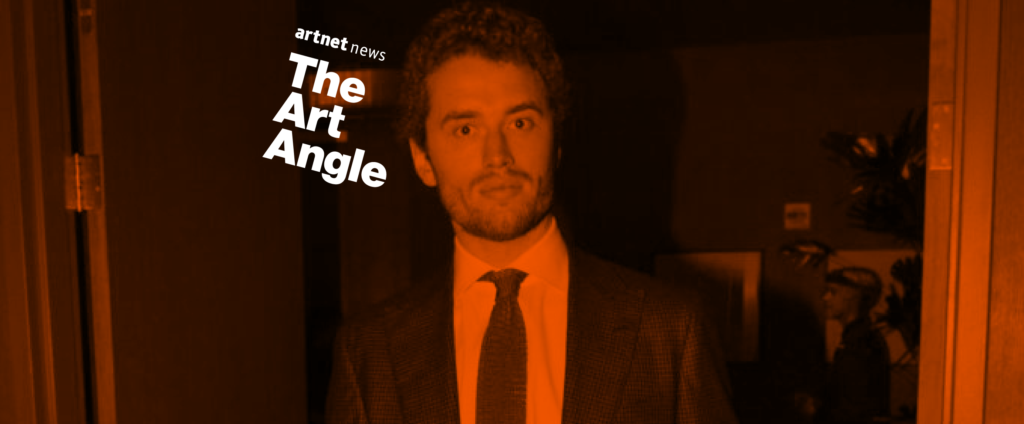The Art Angle
The Art Angle Podcast: How an Art-Dealing Prodigy Became the Market’s Most Wanted Outlaw
This week, senior market reporter Eileen Kinsella helps to untangle the twisted saga of fugitive art dealer Inigo Philbrick.

This week, senior market reporter Eileen Kinsella helps to untangle the twisted saga of fugitive art dealer Inigo Philbrick.

Artnet News

Welcome to the Art Angle, a podcast from Artnet News that delves into the places where the art world meets the real world, bringing each week’s biggest story down to earth. Join host Andrew Goldstein every week for an in-depth look at what matters most in museums, the art market, and much more with input from our own writers and editors as well as artists, curators, and other top experts in the field.
A man on the run, millions of dollars missing, major artworks with multiple claims to ownership: these aren’t plot points in the latest Hollywood blockbuster, they’re elements of the real-life rise, fall, and disappearance of the young art dealer Inigo Philbrick.
The son of a lauded museum director and a graduate of the esteemed Goldsmiths University of London, Philbrick got his start in the art market as an intern at the world-renowned White Cube gallery at the tender age of 23. There, under the tutelage of founder Jay Jopling, he quickly rose through the ranks to lead a successful in-house private-sales division, before striking out on his own as a big-money dealer who would go on to boast permanent spaces in London and Miami, central seats at every major evening auction (where he was a frequent buyer and third-party guarantor), and a lavish lifestyle punctuated by private-jet flights around the world and even a celebrity-socialite paramour.
In short, Philbrick seemed to be the art market’s golden child—until in late 2019, the lawsuits against him started landing fast and furious. Suddenly, the one-time prodigy stood accused of forging legal documents, refusing to pay enormous debts, and literal double-dealing of artworks priced in the millions of dollars each. And rather than stay and defend himself in court, Philbrick instead vanished into thin air, leaving his one-time partners and clients to fight over scraps.
Today, reams of legal documents point to his apparent modus operandi: selling the same partial shares of pieces by in-demand artists to multiple profit-hungry high-rollers looking for a quick-yet-juicy return on investment, as well as using art-backed loans to wring cash out of works whose true ownership may have been questionable at best. The key to these strategies? A willingness to exploit the many gray areas within an increasingly financialized art market, where handshake deals and blind faith still too often substitute for due diligence and rigorous contracts.
So how did so many members of the art world’s elite become unwitting co-stars in our industry’s own version of The Big Short? How high might the losses climb by the time this sordid saga ends? And where, exactly, has the art market’s most-wanted man gone? On this week’s episode of the Art Angle, senior market reporter Eileen Kinsella unspools the twisted tale of Inigo Philbrick, which she reported on in depth for Artnet’s Spring 2020 Intelligence Report.
Listen above and subscribe to the Art Angle on Apple Podcasts, Spotify, SoundCloud, or wherever you get your podcasts. (Or catch up on past episodes here on Artnet News.)
The Art Angle Podcast: Is the Museum of Ice Cream the Future of Art, or Just a Sugar Rush?
The Art Angle Podcast: What Is Saudi Arabia Trying to Do With Contemporary Art?
The Art Angle Podcast: How Hollywood Finally Fell for the Art Market
The Art Angle Podcast: How Jeffrey Epstein Made the Art World His Hunting Ground
The Art Angle Podcast: How the Art World Fell Under the Spell of the Occult
The Art Angle Podcast: Nicolas Party on Why Being an Art Star Is Like Being in Love
The Art Angle Podcast: What Do the Protests in Hong Kong Mean for Art?
The Art Angle Podcast: Four Predictions on How the Art World Will Transform Itself in 2020
The Art Angle Podcast: The Radical, Viral Artworks That Defined the 2010s
The Art Angle Podcast: How an Artist’s $120,000 Banana Ate the World